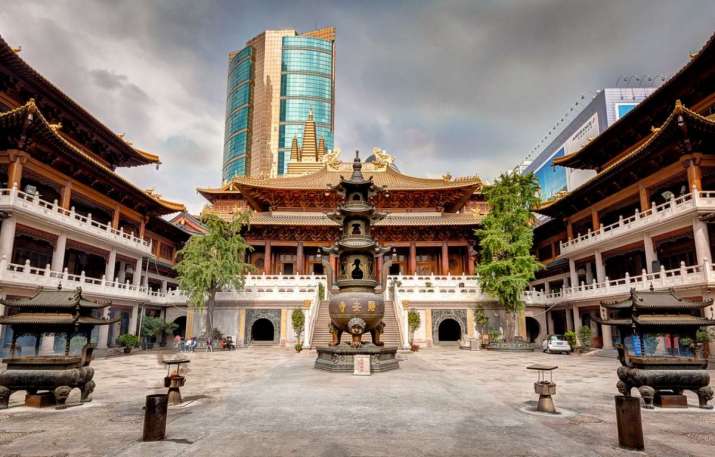
Between an increasingly irrepressible thirst for spirituality and a gradual alignment of religious policy with party ideology, how does the situation of Buddhism look in Mainland China?
Xuan Fang is Associate Professor at the Department of Religious Studies at Renmin University of China, Beijing. In this incisive two-part interview, he shares his first-hand observations drawn from government religious policy, the most recent movements in the Buddhist community, growing cultural interest in Buddhism, and the sub-culture of fo-xi most commonly circulated online by young people.
Both segments of this article were translated with permission from their original entries in issues 429 (May 2019) and 430 (June 2019) of Humanity Magazine (人生雜誌), which is published by Dharma Drum Mountain.
Question 1 (Q1): What do young people in Mainland China think of “faith,” and what are their attitudes towards Buddhism?
Xuan Fang (XF): In Mainland China, there is so far no particularly authoritative research or study that can give a broad understanding of Buddhism among young people. Yet generally speaking, young people’s interest in their own cultural tradition has been rising alongside China’s general development. In the elective course on Buddhism that I offer, I asked students to submit an assignment in the first lesson, requiring them to write their impression on Buddhism, as well as how they get to know Buddhism. I found that young people’s impressions about Buddhism still mainly came from literature, movies, and TV, such as Journey to the West and TV series adapted from Jin Yong’s martial arts novels. Or they would be movies like Shaolin Temple, or even online games. Rarely did their impression come from any serious source, such as a Buddhist master or scripture.
In another example, on the Internet there are the so-called romantic poems written by the sixth Dalai Lama, which in fact were the works of a female poet of his time. They became popularized through mass media such as film director Feng Xiaogang’s movies, triggering the interest of many people in Buddhism. Such channels of information acquisition inevitably render young people’s understanding of Buddhism fragmented and often incorrect.
People in politics and education often see youngsters that are interested in Buddhism as potential preaching targets. In fact, from my observations in my classes, many of them are not. It is rather difficult for these young students to acquire comprehensive, systematic, and reliable Buddhist information. In the textbooks they’ve studied since their childhoods, they are exposed to mostly negative presentations such as “religion is the opium of the masses,” which gives them a negative impression of Buddhism, even relegating it to superstition. For that reason, as one of the few state universities that offer various Buddhist studies programmes, Renmin University provides a precious opportunity for our future elites of society to understand Buddhism in a relatively objective, rational, and in-depth manner.
I would emphasize to my students that Buddhism offers a complete set of values, framework of thinking, life philosophy and practices of living, and so on. Regardless of whether they believe in it or not, Buddhism can be a resource for them when they begin to seriously contemplate the meaning of life and the path they wish to take. I definitely do not preach, but I do guide them to conduct more serious and in-depth study of Buddhism.
Christians preach very actively. There were three million Christians in 1982, but the number had increased drastically to 38 million by 2018, certainly a miracle in its history of development. It has flourished despite various obstacles. Higher institutions such as Renmin University and Peking University have been the focus of Christian work on the young. Christians proactively offer opportunities for young students, such as group activities, church, or festivities such as Christmas gatherings. They are very experienced in this area and understand young people better. Therefore, followers or not, young people in general have quite a good impression of Christianity.
Buddhism, on the other hand, is not active in spreading its teachings. Its attitude is still essentially that of, “take the bait if you want it.” Yet, the number of young people with religious needs is increasing. There was the Zen Society in Peking University in the 1990s. Later on, similar associations were set up in Renmin University, Tsinghua University, and Beijing University of Posts and Telecommunications. Other organizations like vegetarian or vegan societies also became platforms for students with Buddhist beliefs to participate in.
Q2: How would you interpret the popularity of the social phenomena called fo-xi over the past two years?
XF: The term fo-xi probably became widely popular in late 2017. In 2018, it was included in the Top Ten Buzzwords of the Year, and became a label. However, there is no commonly endorsed understanding among people in terms of what the form and the substance this label refers to, and people simply take what they need. Some take it as referring to an attitude like, “Whatever,” “Any way is ok,” or “It doesn’t matter!”. Some take it as a pan-cultural, minor household term. Some interpret it postively, others more critically or negatively.
Many people claiming themselves to own fo-xi have, in fact, never truly encountered Buddhism. They imagine that Buddhism does not fight for anything, and so ascribe themselves the term. I think the term isn’t quite the same as other Internet buzzwords. Its meaning is malleable and heavily context-dependent, and so the meaning can be easily expanded. I anticipate that it will stay popular for quite some time.
While the term doesn’t have a particularly close relationship with Buddhism in reality, it very accurately describes a contemporary trend in Chinese society that reflects wider social problems. In Mainland China, nationalism expresses and promotes an ideology that demands not just obedience or devotion but a certain kind of patriotic enthusiasm, whereas commercial culture or capitalism pushes an illusory model for success, trying to convince young people that only by obeying their boss and overworking themselves can they succeed.
Despite this attempt to drum up enthusiasm on both fronts, currently we see a tendency of faltering social mobility in Chinese society. Channels for upward mobility are slowly ossifying and becoming more rigid. When it’s hard for youngsters in general to imagine a grand future for themselves, it’s hard for them to feel motivated by or sympathetic to the grand stories advocated by national power or capital accumulation. On the contrary, they have this sense of helplessness in being repeatedly manipulated, and as a consequence would rather respond by retreating, feeling alienated, and even behaving indifferently through this way of “whatever” and “never mind.”
Yet it’s hard to capture what the term refers to. Most young people born in the 1990s and 2000s claiming themselves to be fo-xi are the only children in their families. They were sheltered by their parents and grandparents since birth. They are used to being cared by others. Being so, they too rarely have the idea of harming others. They are psychologically much healthier than those born in the 1980s and 1970s. On the other hand, the generation preceding the fo-xi youngsters is a very special group. Having experienced the Cultural Revolution and the June 4th Incident, with profound memories of social trauma, they naturally regard all grand stories or overarching narratives with a cautious eye. At the same time, being beneficiaries of reform and opening up, most fo-xi youngsters come from families with a sound financial foundation laid by their parents.
Their sense of poverty and hunger for material goods are not as strong, and so their mentality tends to be one of “whatever is okay” and “it doesn’t matter.” There is another scenario, though. Some fo-xi youngsters have parents who work hard to make a living as labourers after moving into the city from the countryside. Yet their children also become rather fo-xi and prefer living on their parents’ hard-earned money instead of working hard themselves. Such fo-xi youngsters are often criticized in public forums.
In my opinion, as the term fo-xi gains popularity, people’s stereotypes about Buddhism grow, and they believe that Buddhism advocates a life attitude that lacks ambition and commitment. However, this is a deep-rooted misunderstanding of Buddhism in terms of its basic spirit, because it overlooks the fact that Buddhism possesses very clear and active values, and it requires its followers to have the courage of turning such values into actions tirelessly persistently. This corresponds to “right view, right resolve and right effort.” It is precisely the core values of Buddhism that have been removed from the understanding of the term fo-xi.
Despite its vague reference and the diversity in its understanding and usage, the fact that the term has aroused such widespread discussion suggests that it does reflect common problems in Chinese society. This is the point that we should keep our eye on.

Q3: How does current religious policy in Mainland China affect the religious sector?
XF: The relationship between the government and religion has always been a crucial consideration since 1949. This is the premise for understanding how religious policy on the Mainland affects Buddhism. In fact, this applies to all religions and not just Buddhism. Nevertheless, there have been plenty of changes in religious policy. Since the 18th CPC National Congress, religious policy has emphasized the priority of rectifying deviations. The party realized that its influence in the ideological field had been declining, and so it adopted various policies to regain its leadership in this key area. It sees religion and the religious sector as the most important social field and stratum that is capable of competing for leadership and influence. As a result, not only Buddhism, but all religions, have sensed a certain pressure over the past few years.
As far as the central government is concerned, governments at the provincial and prefectural levels have placed much importance on the regional competition of economic development, and consequently have either openly or covertly advocated “religion sets the platform and economy performs the song” by letting various commercial enterprises develop famous mountains and monasteries that possess religious and cultural resources, thinking that this would meet the needs of economic transformation while not causing any pollution.
As a result, the religious-economic mode of building giant Buddha statues and scenic districts became quite popular, causing a serious commercialization in the fields of Daoism and Buddhism. At the same time, conflicts intensified due to the inadequacies of prefectural governments, which were “not willing, nor dare, nor able to regulate.” In light of this, the central government considered it necessary to tackle the issue at the root by restoring the party’s basic guidance policies, and that the urgent task in the fields of Buddhism and Daoism was to restrain and combat the commercialization of religion.
Seeing how the central government has raised religious matters to a political level and deployed rather severe language, local governments naturally adjusted by actively cooperating. Yet at times, their approach tended to be simplistic and crude.
For instance, recently the Hebei government blew up an outdoor Guanyin statue, although initially it approved the tendering of building the statue by excavating the mountain. The incident may appear distressing in the eyes of Buddhists outside Mainland China. In fact, even the Chinese Buddhist leadership resents this kind of statue building, because it is an entirely commercial action, with nothing to do with the Buddhist sector, nor is it out of and sincere Buddhist faith. Therefore, it is reasonable to combat commercialization, and even the Buddhist sector supported that. But if it’s done in an over-simplistic, rough and uncompromising manner, innocent people are likely to be affected as well, thus causing much stress to the Buddhist sector as well as reinforcing unpleasant perceptions.
In addition, the most widespread and direct impact of the tightening of religious policy is a full restriction on the public space of religious expression, especially online space. Public religious expression was greatly compressed. Notices were put up at the entrances of some monasteries, with words like “No unauthorized entry for minors aged below 18 and CPC members.” To many, this could be an outright deterrent to those trying to know more about religion. Yet, how effective is this? While there may be temporary negative effects, it is useless in the long term, since religious needs will only go underground when public channels are blocked. It’s better to channel religious needs rather than blocking them.
The process of reform and opening up in the Mainland over the past 40 years is equivalent to what Europe and the US has gone through 400 years. Religious needs in the end are not an anthropological constant, and cannot be infinitely suppressed. At a time when social transformation takes place so drastically, it is abnormal for religious needs not to be strong. I often say that the current principal contradiction in the religious field is the sharp conflict between drastically increasing and diversifying religious needs and the outdated resources and control that traditional institutions provide.
Yet, being inflexible and unable to keep up with the times, certain measures fail to improve management by formulating rules and standards to channel and release those non-toxic religious resources so that they meet the needs of long-term stability for state and society. Instead, simplistic and rough executive edicts were adopted. Such ineffectual ways distort the supply and demand relationship of the religious market, and in the long term may even aggravate the chaotic situation of the religious field by creating religious gray areas and giving birth to new religions.
Contemporary Chinese Buddhist Trends, Part Two: Observations on Sinicized Buddhism






